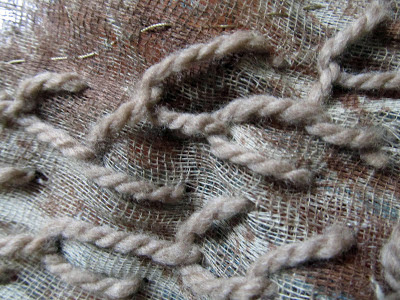I was invited to participate in a show called "By the Yard" and it has a really unique concept: Artists can create textile yardage and that yardage can than be used to create other works.
We were asked to create a minimum of five yards of a surface designed textile - all other parameters were up to the artist.
My concept was inspired by my daily walk to work each day through a cedar forest; I’m calling it “Essence of Cedar”. I've attempt to capture the effect of light being filtered by the dense tree boughs, the texture of the bark and the lichens growing on the trees and the minimal color palette – greens, orange, browns and grays.
The base is taupe striped gauze; that has been block printed with a stylized cedar bough pattern in both green and orange to represent both living and dropped boughs.

My print block was pretty low tech - craft foam cut to shape and glued to a worn Plexiglas quilt ruler. The clear ruler proved to be a great idea, as I could see where I was placing each print and it helped keep me semi level. I wasn't terribly concerned with very precise placement, as the result was intended to be organic.
The tree trucks were than embroidered with merino wool for added texture.
And embroidered lichen was added.
Done!
I then appliqued the stylized cedar trunks by placing the printed gauze over my tree pattern and overlaying a second piece of gauze that had been sponge printed, then I hand stitched the pattern and cut away the excess.
The tree trucks were than embroidered with merino wool for added texture.
And embroidered lichen was added.
As usual, I started with a plan that had to be altered a bit, but I'm pleased with the final result - I've even created something with the scraps, to be revealed soon!
If you're in the area, stop by the show and enjoy all the other work in the gallery too.






















